Normally I am not too annoyed by some general language use changes that we as a culture introduce now and then. One item that I notice and get slightly agitated about is the lack of adverb use. While watching television, one of the TV personalities said something that highlights exactly why I like adverbs.
TV person: "How bad do you want it?"
Well, if you want to know how "badly" they want the implied prize or benefit conferred by the program that's one thing. But I imagined another meaning at first. Let's slightly rephrase the statement to say, "how bad do you want this sandwich?"
I can think of two interpretations. 1) How great is your desire for the sandwich? 2) How horrible and lousy would you like the sandwich to be? Do you want it just kind of bad, or should I spit into it before serving it to you?
If you aren't moving at a snail's pace, you aren't moving at all. -Iris Murdoch
Saturday, January 26, 2013
Wednesday, January 23, 2013
10,000 Snails!
I've been busy. The semester is starting up again, so that means another round of rocks, minerals, volcanoes, earthquakes, rivers, aquifers, deserts, and glaciers (to name a few). I've also been frantically counting snails during the winter break. I've spent about 10 days this month going through the snail shells my student researchers have meticulously plucked from sifted samples of leaf litter (a nice double alliteration, that - triple if you count the 'eff' sounds).
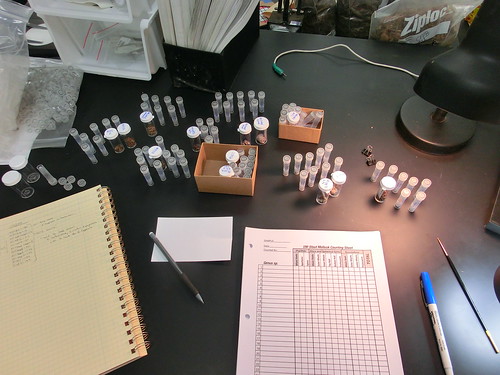
This is what sorting snails from a sample looks like. Organized by species from each site, each individual snail marked on the tally sheet. The counting sheet is set up to record fragments and each of those mutually exclusive pieces contributes to the total. Thus, if I have ten complete shells plus one aperture and four spires, I can reasonably assume that I have at least fourteen individuals, since one of the spires may have broken off the aperture.
The minimum number of individuals for each species becomes a measure of abundance at a particular site, while the total number of species at a site is its diversity. Some sites are more diverse than others. Some sites have low diversity but high abundance, while other sites have high diversity and high abundance. In addition to simple numbers, there are species of snails that show up at many sites and there are species of snails that only show up at a few sites. The species of snails that only found at a few sites are of particular interest for our research - are they limited to special environmental conditions? Are they rare because they are specially adapted to a particular habitat, or has our history of land use and alteration changed a once favorable landscape?
I don't have a lot of answers to these questions yet, but the report on our findings is due to the Department of Natural Resources at the end of the summer. And that report needs data - the rather tedious data that comes from picking, identifying, and counting snails. And many of these snails are quite small. Some of them are less than two millimeters long. And so I've spent many hours sorting, identifying, and counting snails. And piling up a huge stack of tally sheets.
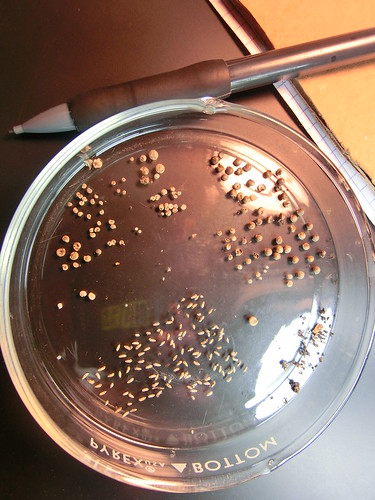
Here's a selection of tiny snails, sorted into species, ready to be counted and placed into their very own container for reference and eventual storage in a museum collection to aid future research.
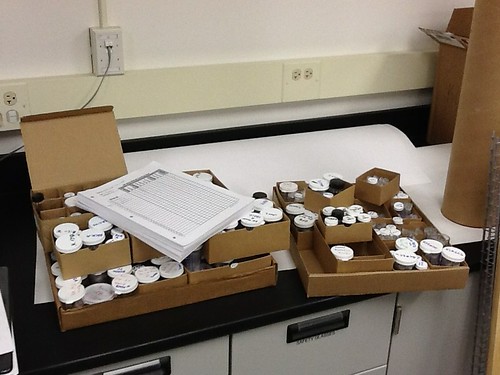
The results so far: vials of snails and a stack of tally sheets.
And so it was that I began adding up the total number of individuals from the tally sheets. A number that got bigger and bigger as I kept going. 1,000... 2,000, 4,000 and the number kept growing. 5,000... 7,000... 9,000... at 9,847 I realized that I would soon cross a rather nice landmark. So I sat down today to count a few more shells. I pulled out a sample and quickly climbed up to nearly 9,980. The next sample had only a few shells and brought me to 9,993. So close. I opened up a third sample - the first species had only three shells. The next one I opened also had three. So the next vial would be it. I pulled out a container with a rare snail that I had only found at a few places, and there were two shells. The first one I saw was a nice, large specimen of Vitrina angelicae.
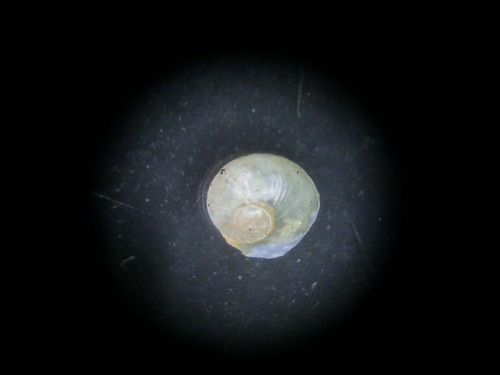
Our work in western Wisconsin is one of the first such surveys in this part of the state. Many of the species represent the first county records. For example, here's a map from the DNR showing where they have records of this species' occurrence. Currently, V. angelicae is listed as a "species of conservation need" meaning that we just don't know enough about this animal to say whether or not its endangered, threatened, or just shy.
I've blogged about the bias in snail distribution data from Wisconsin before - our research has been adding many new patches of blue in the western counties. Despite the tedious and time-consuming nature of this kind of work, it's immensely satisfying to know that the 10,000th snail I've counted is helping stretch the known range of this snail across Wisconsin, giving us a better idea of what we've got and just how precious it is.

This is what sorting snails from a sample looks like. Organized by species from each site, each individual snail marked on the tally sheet. The counting sheet is set up to record fragments and each of those mutually exclusive pieces contributes to the total. Thus, if I have ten complete shells plus one aperture and four spires, I can reasonably assume that I have at least fourteen individuals, since one of the spires may have broken off the aperture.
The minimum number of individuals for each species becomes a measure of abundance at a particular site, while the total number of species at a site is its diversity. Some sites are more diverse than others. Some sites have low diversity but high abundance, while other sites have high diversity and high abundance. In addition to simple numbers, there are species of snails that show up at many sites and there are species of snails that only show up at a few sites. The species of snails that only found at a few sites are of particular interest for our research - are they limited to special environmental conditions? Are they rare because they are specially adapted to a particular habitat, or has our history of land use and alteration changed a once favorable landscape?
I don't have a lot of answers to these questions yet, but the report on our findings is due to the Department of Natural Resources at the end of the summer. And that report needs data - the rather tedious data that comes from picking, identifying, and counting snails. And many of these snails are quite small. Some of them are less than two millimeters long. And so I've spent many hours sorting, identifying, and counting snails. And piling up a huge stack of tally sheets.

Here's a selection of tiny snails, sorted into species, ready to be counted and placed into their very own container for reference and eventual storage in a museum collection to aid future research.

The results so far: vials of snails and a stack of tally sheets.
And so it was that I began adding up the total number of individuals from the tally sheets. A number that got bigger and bigger as I kept going. 1,000... 2,000, 4,000 and the number kept growing. 5,000... 7,000... 9,000... at 9,847 I realized that I would soon cross a rather nice landmark. So I sat down today to count a few more shells. I pulled out a sample and quickly climbed up to nearly 9,980. The next sample had only a few shells and brought me to 9,993. So close. I opened up a third sample - the first species had only three shells. The next one I opened also had three. So the next vial would be it. I pulled out a container with a rare snail that I had only found at a few places, and there were two shells. The first one I saw was a nice, large specimen of Vitrina angelicae.

Our work in western Wisconsin is one of the first such surveys in this part of the state. Many of the species represent the first county records. For example, here's a map from the DNR showing where they have records of this species' occurrence. Currently, V. angelicae is listed as a "species of conservation need" meaning that we just don't know enough about this animal to say whether or not its endangered, threatened, or just shy.
I've blogged about the bias in snail distribution data from Wisconsin before - our research has been adding many new patches of blue in the western counties. Despite the tedious and time-consuming nature of this kind of work, it's immensely satisfying to know that the 10,000th snail I've counted is helping stretch the known range of this snail across Wisconsin, giving us a better idea of what we've got and just how precious it is.
Sunday, January 20, 2013
Center Pivot Irrigation: Yer Doin' It Wrong
Another neat post linked by the Geodynamic Duo at Highly Allochthonous: Center Pivot Irrigation. Here in west-central Wisconsin, this is a pretty common practice along the broad, flat lowlands that occupy much of the landscape. But something must have malfunctioned with the drive or whatever movement regulator they had on one just outside of town:

Oops. Looks like the radius of the pivot was about 20 feet beyond the utility pole.
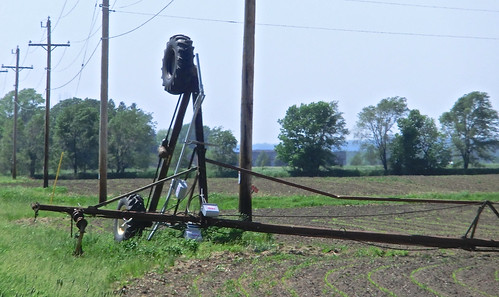
Closer view showing the dent in the strut - that's pretty impressive for something that doesn't move very fast.

Oops. Looks like the radius of the pivot was about 20 feet beyond the utility pole.

Closer view showing the dent in the strut - that's pretty impressive for something that doesn't move very fast.
Parallel Ideas
This is shiny - Jane over at Geo-Heritage Science (golly, my knowledge of cool, active geology blogs is getting getting more out of date every day) has a fun exploration of the online gaming world "Skyrim" and how what exists in-game can provide us with enough information to reconstruct a "synthetic" geologic history.
I've started up something similar, but research demands have sidelined my post until later (perhaps this will motivate me to finish it up tonight or tomorrow). But here's a little preview:
I've started up something similar, but research demands have sidelined my post until later (perhaps this will motivate me to finish it up tonight or tomorrow). But here's a little preview:
Thursday, January 10, 2013
Climates Change...
Earth. Our Home. A home that has been changing - and will continue to do so regardless of our opinions on the matter. But this year, we've got a reminder that for all Earth's indifference to us, we can still alter our surroundings. 2012 was the warmest year on record in the United States. At least, since we've been keeping track of these kinds of things. And while 2013 may not be even warmer, heck, the variations in climatic patterns could (although highly unlikely) give us a colder than normal year. But don't take one year's worth of observations as the final and definitive proof of global warming.
Take it as yet another - albeit dramatic - road sign on the route we as a culture seem to be determined to travel. Think of it as one of those yellow highway markers that give you a last warning before the lane ends. If you like driving within marked lanes (or on pavement at all), you best merge now, before you find yourself in the ditch. I used the road metaphor on purpose, since our constant demand for fossil fuels is contributing to the atmosphere's ability to retain heat. But rather than musing on our current predicament, I'm going to share a picture from my trip to Scotland:

This settlement is about 5,000 years old, being inhabited between about 3200 – 2500 BCE. Although I'm not really comfortable with this "BCE" (Before Common Era) title any more than I am with "BC." Because whose "common era" is it anyway? But these Neolithic inhabitants didn't pick this site because of it's ocean view. 5,000 years ago when they were here there was a marshy wetland and lake where there is ocean right now. The coast was many, many meters away. They were, after all, just a few millenia out of the last glacial maximum and as melting glacial ice continued to drain into the oceans, ocean levels have since raised by another 2-5 meters (give or take).
And thanks to a strong storm in 1850, the shifting dunes revealed this long-buried structure, giving us a rare glimpse into the homes and habits of an ancient culture. Climate changes - whether we want it to or not. We're faced with a particularly unique issue today, since the atmospheric conditions that foster warmer surface temperatures are largely of our own making. But as a species, we've dealt with dramatic shifts in climate before. Whether we're forced into a
"new" neolithic era is largely up to us.
Take it as yet another - albeit dramatic - road sign on the route we as a culture seem to be determined to travel. Think of it as one of those yellow highway markers that give you a last warning before the lane ends. If you like driving within marked lanes (or on pavement at all), you best merge now, before you find yourself in the ditch. I used the road metaphor on purpose, since our constant demand for fossil fuels is contributing to the atmosphere's ability to retain heat. But rather than musing on our current predicament, I'm going to share a picture from my trip to Scotland:

This settlement is about 5,000 years old, being inhabited between about 3200 – 2500 BCE. Although I'm not really comfortable with this "BCE" (Before Common Era) title any more than I am with "BC." Because whose "common era" is it anyway? But these Neolithic inhabitants didn't pick this site because of it's ocean view. 5,000 years ago when they were here there was a marshy wetland and lake where there is ocean right now. The coast was many, many meters away. They were, after all, just a few millenia out of the last glacial maximum and as melting glacial ice continued to drain into the oceans, ocean levels have since raised by another 2-5 meters (give or take).
And thanks to a strong storm in 1850, the shifting dunes revealed this long-buried structure, giving us a rare glimpse into the homes and habits of an ancient culture. Climate changes - whether we want it to or not. We're faced with a particularly unique issue today, since the atmospheric conditions that foster warmer surface temperatures are largely of our own making. But as a species, we've dealt with dramatic shifts in climate before. Whether we're forced into a
"new" neolithic era is largely up to us.
Saturday, January 05, 2013
Tuesday, January 01, 2013
Don't worry about the Kilogram overmuch
The link on twitter from mentalfloss.com raised my eyebrows: "The Not-So-Perfect Kilogram and Why the Metric System Might Be Screwed"
For a science person like me, my first reaction was bemused curiosity. Then I read the article. The things mentioned have been discussed many, many times by physicists and others interested in pinning down our system of measurement into universal constants. It's kind of like how our great grandparents often wrote their recipes to specify the quantities of things using the tools they had available. A "cup" of sugar might have meant your great grandmother Ingrid's favorite coffee cup (actual volume: 9.5 oz), or great-great-granddad's tin cup that he brought back from Germany (actual volume 6 oz). Making a recipe with the wrong cup might mean very sweet - or very sour - lemon merengue pie if made with a standard measuring cup (8 fluid ounces or about 240 mL).
Now imagine these vagaries applied to the world of the very large, or very small, or very dangerous. Not the kinds of wobbles that lend any sense of certainty to measurements of the natural world.
So back to the article itself. The headline is absolute sensationalism. And I find it utterly annoying. The kilogram is not doomed to oxidize away, or be handled into oblivion. We have a universal constant - Avogadro's Number to represent exactly how many atoms are in a certain amount of something. In this case, that certain amount is called a "Mole." Pronounced like the burrowing mammal (or the benign skin tumor), not the sauce. One Mole of Carbon contains 6.022x1023 atoms of carbon. That's Six Hundred Two Septillion atoms...
And one Mole of pure Carbon-12 (a carbon atom with 6 protons and 6 neutrons) would have a mass of 12 grams. A Mole of carbon you might pull out of a tree or something just lying around would have a mass slightly larger (12.011 grams) because there is a small fraction of Carbon-13 and Carbon-14 knocking about and getting involved with all of the regular Carbon-12. So defining the Kilogram in terms of an absolute number of pure atoms is easy and already done. But establishing this easy-to-reproduce-in-your-lab standard is much trickier, since atoms are so small and there are so many atoms in a mole.
If using Platinum (Pt, atomic number 78) one Mole would have a mass of 195 grams. So if you had 5.128 Moles of Platinum, you'd have your perfect kilogram (within a few hundredths of a percent due to rounding). Incidentally, that works out to about 40 milligrams - a bit more than the difference of 0.05 milligrams mentioned in the above article. But not bad for zero dollars and about 5 minutes of scratching around with a calculator...
Platinum, however, is a rather expensive material - most of us don't have that much platinum around. And on today's market, 1 Kg of Platinum would get you almost $50,000. But what about Silicon? There's lots of Silicon - it's the second most common element on (and in) the earth. 1 Mole of Si would have a mass of 28.09 grams, therefore you'd need about 35.6 Moles to get your Kg standard. So how could we count all those atoms? By using x-ray crystallography, we can get a pretty good estimate on how many atoms there are in one cubic centimeter (the meter, by the way, is defined in terms of the speed of light and the distance travelled in one second - the second being defined as 9.2 billion oscillations of a Cesium-133 atom, but I digress). Once we know how many atoms in a given volume we have, all that remains is to manufacture that perfect object with that precise volume. We're talking "perfect" here - beyond even "repaired hubble telescope mirror perfect." But that's more of a limit of technology than theory - I've read about some of these attempts at a perfect silicon sphere in a science magazine a few years ago.
And so, in the end, I was largely unimpressed by the suggested immediacy of the little bit of trivia, but I'm glad things like this do get attention. Because efforts to establish more reliable measures and better define these "constants" affect our everyday lives. But don't throw out your Ikea custom-molded measuring cups in hopes of a more accurate polished Silicon version. For most of the time, what we've got in our cupboards is more than enough to make a good pie.
For a science person like me, my first reaction was bemused curiosity. Then I read the article. The things mentioned have been discussed many, many times by physicists and others interested in pinning down our system of measurement into universal constants. It's kind of like how our great grandparents often wrote their recipes to specify the quantities of things using the tools they had available. A "cup" of sugar might have meant your great grandmother Ingrid's favorite coffee cup (actual volume: 9.5 oz), or great-great-granddad's tin cup that he brought back from Germany (actual volume 6 oz). Making a recipe with the wrong cup might mean very sweet - or very sour - lemon merengue pie if made with a standard measuring cup (8 fluid ounces or about 240 mL).
Now imagine these vagaries applied to the world of the very large, or very small, or very dangerous. Not the kinds of wobbles that lend any sense of certainty to measurements of the natural world.
So back to the article itself. The headline is absolute sensationalism. And I find it utterly annoying. The kilogram is not doomed to oxidize away, or be handled into oblivion. We have a universal constant - Avogadro's Number to represent exactly how many atoms are in a certain amount of something. In this case, that certain amount is called a "Mole." Pronounced like the burrowing mammal (or the benign skin tumor), not the sauce. One Mole of Carbon contains 6.022x1023 atoms of carbon. That's Six Hundred Two Septillion atoms...
And one Mole of pure Carbon-12 (a carbon atom with 6 protons and 6 neutrons) would have a mass of 12 grams. A Mole of carbon you might pull out of a tree or something just lying around would have a mass slightly larger (12.011 grams) because there is a small fraction of Carbon-13 and Carbon-14 knocking about and getting involved with all of the regular Carbon-12. So defining the Kilogram in terms of an absolute number of pure atoms is easy and already done. But establishing this easy-to-reproduce-in-your-lab standard is much trickier, since atoms are so small and there are so many atoms in a mole.
If using Platinum (Pt, atomic number 78) one Mole would have a mass of 195 grams. So if you had 5.128 Moles of Platinum, you'd have your perfect kilogram (within a few hundredths of a percent due to rounding). Incidentally, that works out to about 40 milligrams - a bit more than the difference of 0.05 milligrams mentioned in the above article. But not bad for zero dollars and about 5 minutes of scratching around with a calculator...
Platinum, however, is a rather expensive material - most of us don't have that much platinum around. And on today's market, 1 Kg of Platinum would get you almost $50,000. But what about Silicon? There's lots of Silicon - it's the second most common element on (and in) the earth. 1 Mole of Si would have a mass of 28.09 grams, therefore you'd need about 35.6 Moles to get your Kg standard. So how could we count all those atoms? By using x-ray crystallography, we can get a pretty good estimate on how many atoms there are in one cubic centimeter (the meter, by the way, is defined in terms of the speed of light and the distance travelled in one second - the second being defined as 9.2 billion oscillations of a Cesium-133 atom, but I digress). Once we know how many atoms in a given volume we have, all that remains is to manufacture that perfect object with that precise volume. We're talking "perfect" here - beyond even "repaired hubble telescope mirror perfect." But that's more of a limit of technology than theory - I've read about some of these attempts at a perfect silicon sphere in a science magazine a few years ago.
And so, in the end, I was largely unimpressed by the suggested immediacy of the little bit of trivia, but I'm glad things like this do get attention. Because efforts to establish more reliable measures and better define these "constants" affect our everyday lives. But don't throw out your Ikea custom-molded measuring cups in hopes of a more accurate polished Silicon version. For most of the time, what we've got in our cupboards is more than enough to make a good pie.
Histories both Natural and Unnatural
I'm kicking a few ideas around in my head - particularly regarding art and geoscience. I'd like to do some additional posts about sketching in the field and making illustrations for technical reports, but I also want to put together posts on fantasy map making. I think I can combine these two themes by looking into the real world and then transplanting that into the realm of the imagination.

So get your pencils&paper, or graphics tablets, or cameras ready. Our first stop will be to look at mountains...
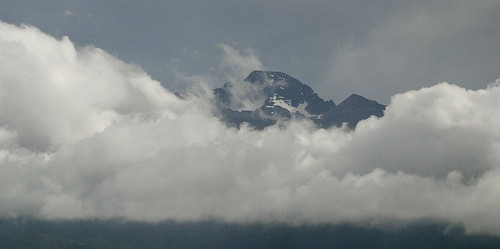

So get your pencils&paper, or graphics tablets, or cameras ready. Our first stop will be to look at mountains...

MERRY NEW YEAR!
Subscribe to:
Comments (Atom)



